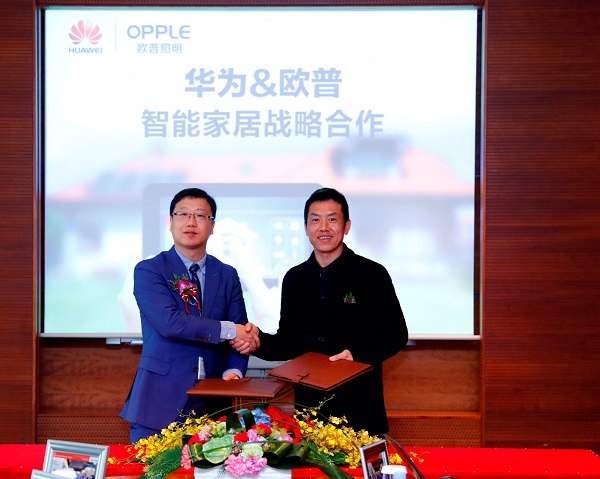(Author: Skavy Cheng, Editor, LEDinsidehttp:// Translator: Judy Lin, Chief Editor, LEDinside)
Opple Lighting and Huawei signed a HiLink Protocol Smart Home Partnership Agreement at the Shanghai Expo Center on Aug. 31, 2016.
Under the agreement, the two companies will collaborate to develop Opple-Huawei HiLink smart lighting products.
The newest agreement was sealed just four months after the two companies signed a Smart Home Strategic Cooperation Agreement on April 20, 2016. This is Opple debut attempt in the smart home sector.
There are many similarities between Opple Lighting’s strategy in the smart home lighting market and Philips Lighting’s IoT market deployment announcement earlier in August 2016.
 |
|
Wang Yaohai, Opple board director (right) and Shao Yang, CSO of Huawei Consumer Business Group (left), at the signing of the Smart Home Strategic Cooperation agreement back in April 20, 2016. (Huawei/LEDinside) |
The competition between Huawei and Cisco
The lighting industry views Opple Lighting’s entry in the smart home sector, and its collaboration with Huawei to hold great potential, for the latter company Opple is just another member of its smart home ecosystem strategy. Huawei has signed smart home ecosystem partnership agreements with 60 partners including Midea Group, Haier, Opple Lighting, Skyworth, Broadlink and others. All these companies products are integrated into Huawei’s electronic appliance online platform through HiLink protocol to create a unified, simple and convenient smart home device.
In contrast, Philips Lighting has partnered up with prominent U.S. technology company CISCO on Dec. 9, 2015 to develop connected lighting products. After 30 years of R&D, CISCO has become the embodiment of “Internet, Internet applications, and productivity”. Cisco has emerged as a leader in nearly every market sector, but in recent years its market dominance has been challenged by Huawei, as the Chinese company’s technology businesses erodes Cisco market shares. CISCO even announced it will layoff 5,500 employees worldwide on Aug. 17, 2016, reported Associated Press.
Opple and Philips different lighting strategy
Opple has joined arms with Huawei in the smart home market sector, with Huawei at the helm of the partnership, and Opple in the background as a member of its large ecosystem network. Forming a partnership with Huawei is a logical step for Opple, which has long been focused on the residential lighting sector.
Philips Lighting on the other hand is directing developments in its partnership with Cisco, where the latter is mainly working on improving Philips connective lighting technology. Even though Philips Lighting’s smart LED bulb Hue is targeting the residential market, its latest products unveiled are in line with its earlier announcements that it will be focused on commercial lighting.
Comparison between Opple Lighting and Philips Lighting product deployment strategy
Opple Lighting’s deployment in the smart home sector strengthens its advantages, and its product position in the residential lighting sector. The colorful Huawei Hilink app can be used to control lighting in the bedroom and dining area, while ambient lighting can be adjusted to meet different lighting scenarios.
Smart LED lighting developed by Philips birthed out of commercial lighting applications, eventually expanding to architectural lighting, office lighting, hotel lighting, and retail lighting. Moreover, the company’s comprehensive product portfolio includes the Philips Hue series, especially designed for residential lighting applications.
Smart LED lighting is starting to pick up in niche lighting markets, according to LEDinside’s latest 2016 Global Lighting Market Report. It is estimated, the global smart LED lighting market size will reach US $2.35 billion by 2016, and by 2020 reach US $13.43 billion, with niche lighting market applications providing the greatest market growth potential.
Even though LED luminaires have entered a low-price competition era, the smart lighting market still holds great market growth potential since it is still in the early phases, and has not reached large scale applications, analyzed Joanne Wu, Assistant Manager, LEDinside. The costs to develop smart lighting software remain high, but as the technology matures and products advance, manufacturers will promote products, resulting in wider market acceptance, and significant market growth.
Despite of Opple Lighting and Philips Lighting’s market strategies, it is difficult to judge where the smart lighting will take off first, it could be in the commercial lighting before it spreads to residential lighting or the other way around. It really will depend on the timing. Moreover, lighting demands still permeate all living spaces, and has become an indispensable part of daily life. Hence, future lighting has further market growth potential in residential lighting and commercial lighting applications.












